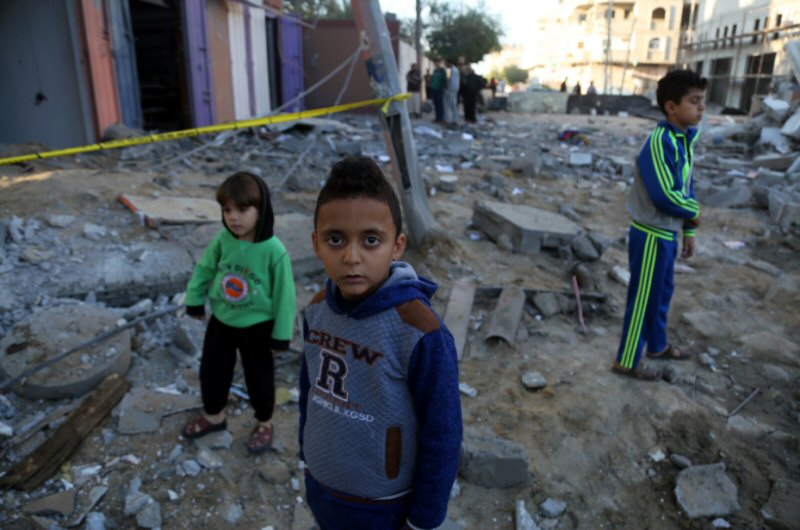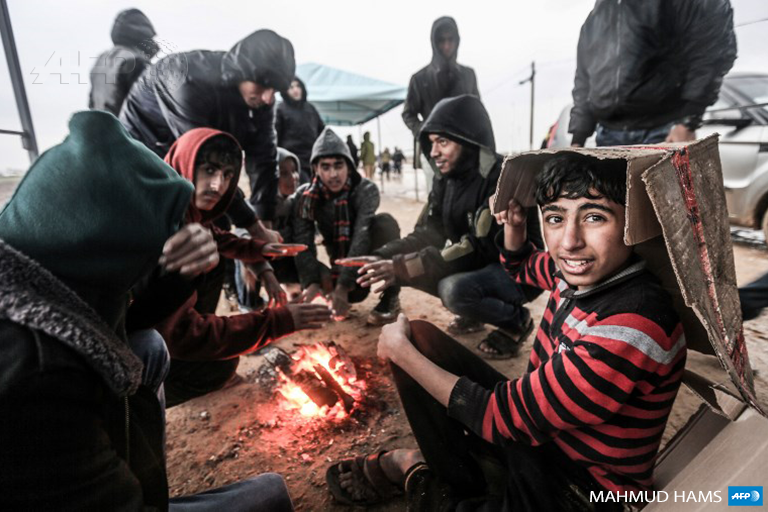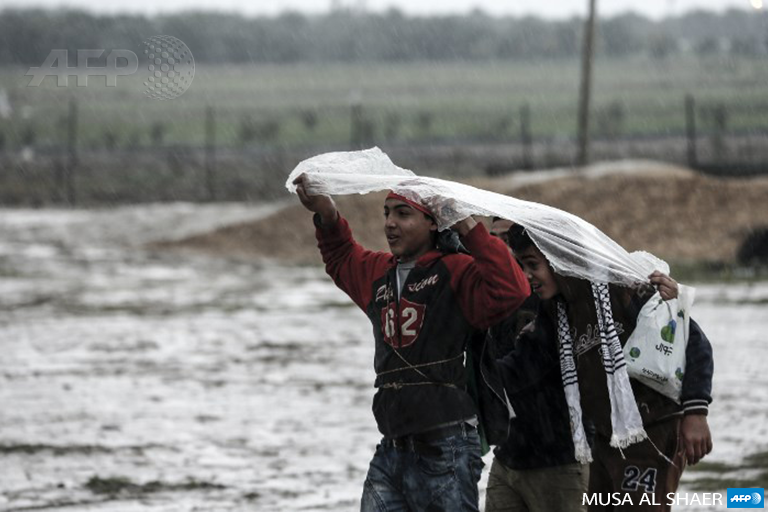www.aljazeerah.info
News, January 2019
Archives
Mission & Name
Conflict Terminology
Editorials
Gaza Holocaust
Gulf War
Isdood
Islam
News
News Photos
Opinion Editorials
US Foreign Policy (Dr. El-Najjar's Articles)
www.aljazeerah.info
|
Editorial Note: The following news reports are summaries from original sources. They may also include corrections of Arabic names and political terminology. Comments are in parentheses. |
56 Palestinian Children Killed by Israeli Occupation Soldiers in 2018
January 2, 2019
Editor's Note:
While brutal force has been used to create Zionist Israel and sustain it thus far, Zionist claims to Palestine are false. Actually, from the five thousand years of known written history, there has been a continuous Palestinian-Canaanite presence in the Holy Land. Despite the Zionist false claims, the ancient Israelites ruled part of the land for only 85 years (during the reign of David, Solomon, and Solomon's son).
After that, the Egyptians conquered Palestine-Canaan in 925 BC, followed by Assyrians, Babylonians, Persians, Greeks, and Romans, before the Arab Muslim rule, starting from 636 AD.
By the Time Jesus started his mission, the three population groups of Canaanites, Palestinians, and Israelites were melted together in religion and language. Most of them became Christians when Constantine converted in 313 AD. Then, most of them became Muslims in the 7th and 8th centuries AD.
So, Palestinian Muslims, Christians, and Jews are the ones who have the right to claim descent from ancient Israelites, Palestinians, and Canaanites, not Zionists from other continents.
The following news stories are just examples of the Israeli occupation government violations of Palestinian human rights, on daily basis.
More detailed news stories can be found at the following sources: https://english.palinfo.com/, http://imemc.org/, https://paltoday.ps/ar/
DCIP: 2018 Reigned Deadly Force On Palestinian Children
January 2,
2019 6:47 AM
IMEMC News & Agencies
 Palestinian children stand near the ruins of the building where Al Aqsa channel was located and which was targeted the night before by an Israeli airstrike, Gaza City, November 13, 2018. (Photo: ActiveStills / Mohammad Zaanoun) Israeli forces continued to kill Palestinian children at an average pace exceeding one child per week in 2018. At the bitter close of 52 weeks, 56 Palestinian children were dead due to Israeli occupation forces’ actions.
12/31/18 Defense for Children International – Palestine (DCIP) Part 1: More than one child killed per weekRamallah, December 31, 2018—The year 2018 was one of deep valleys and few peaks for Palestinian children. Within three days of of ringing in the new year, Israeli forces shot 16-year-old Palestinian Musab Tamimi in the neck during Ramallah-area clashes, killing him, in a violent start to the year. Israeli forces continued to kill Palestinian children at an average pace exceeding one child per week in 2018. At the bitter close of 52 weeks, 56 Palestinian children were dead due to Israeli forces’ actions. One child who reportedly carried out a fatal attack in a settlement was also killed by an Israeli settler. The two most recent child fatalities took place between December 20 and 21. Israeli forces shot and killed Mohammad Muin Khalil Jahjouh, 16, during “Great March of Return” protests near the perimeter fence east of Gaza City on December 21 around 4 pm. Mohammad sustained a gunshot wound to the neck and died shortly after in Shifa hospital, Gaza City. 
Mohammad Jahjouh, 16, from Shati
refugee camp in the central Gaza
Strip died on December 21 after
being shot by an Israeli soldier.
(Photo: Courtesy of Jahjouh family)
“I heard the scream of someone who was about five meters [16 feet] behind me. I turned my back to see what was happening, when I saw a 16-year-old boy lying on the ground with blood running from his neck to his chest,” a journalist who was photographing the protest told Defense for Children International – Palestine. The witness said that Mohammad was standing approximately 150 meters (492 feet) away from the perimeter fence, and some 80 meters (262 feet) away from a group of protestors who were throwing stones at Israeli soldiers stationed on the other side of the perimeter fence when he was shot. Around 9 p.m. on December 20, Israeli forces fired at a car traveling on a road near Beit El settlement, located near the Palestinian city of Ramallah in the central West Bank. A live bullet entered the car, striking Qassim Mohammed Ali al-Abbasi, 17, in the back and killing him, based on DCIP’s initial investigation. An eyewitness told DCIP that Qassim and some friends were travelling from his residence in the East Jerusalem neighborhood of Silwan to Nablus when their vehicle came under heavy shooting. When an Israeli military jeep pulled them over, the witness realized that Qassim was unconscious. Paramedics who arrived on the scene found no pulse and declared the child dead. Also among this year’s child fatalities was Gaza City resident Mohammad Naser Ziad al-Reefi, 13, who suffered a spinal cord injury from an Israeli drone-fired missile strike in 2014. The same strike also killed his twin brother and four other family members. Mohammad succumbed to his wounds November 3, in a central Gaza Strip hospital. Bringing the total number of Palestinian children killed by Israeli soldiers or settlers in 2018 up to 57 was 17-year-old Mohammad Tarek Ibrahim Dar Yousef. An Israeli settler killed Mohammad after the boy reportedly carried out a fatal stabbing attack in the illegal Israeli settlement of Geva Binyamin in the central West Bank on July 26, 2018.
The vast majority of the fatalities, 86 percent, took place in the Gaza Strip. Of these, 46 children were killed by Israeli forces since March 30, often in the context of the “Great March of Return” protests and related activities. This number includes four-year-old Ahmad Yasser Sabri Abu Abed who was struck by bullet fragments on December 7 while in his father’s arms, dying four days later. Live ammunition accounted for 73 percent of the total child fatalities. In a number of cases, DCIP found no evidence that children presented a direct, mortal threat at the time that Israeli forces employed lethal force against them. In one such instance, on April 20, an Israeli sniper stationed on sand hill on other side of separation fence shot Mohammad Ibrahim Ayoub, 14, in the head while he was between 70-200 meters (230-656 feet) from the fence. A witness told DCIP that Mohammad was attempting to run away from tear gas at the time he was shot. Israeli forces shot 16-year-old Ahmad Misbah Abu Tyour in the foot on September 7 in Rafah and he succumbed to his wounds the following day. Video footage of the incident suggests he posed no threat when he was targeted with intentional lethal force. Under international law, lethal force may only be used as a last resort in circumstances where an individual poses an immediate threat to life or threat of serious injury. Despite this, accountability is extremely rare in cases where Israeli forces are accused of committing crimes against Palestinian children. Crowd control weapons proved lethal for four children who died after being struck by tear gas canisters or rubber-coated metal bullets. Crowd control weapons can carry deadly force when they strike children, particularly at close range or on the upper body. In addition to fatalities, DCIP documented a spike in the number of severe injuries to children across the Occupied Palestinian Territory (OPT). In 2018, DCIP documented at least 183 child injuries at the hands of Israeli forces, with 130 of these taking place in the Gaza Strip. Of critical concern are 19 children who suffered permanent disability as a result of injuries. 
Israeli occupation forces take position during a
demonstration near the perimeter fence
between Israel and Khan Yunis in the
southern Gaza Strip on November 9, 2018.
(Photo: AFP / Said Khatib)
Part 2: The “Great March of Return”The “Great March of Return” demonstrations began on March 30, 2018 in protest of Palestinian refugees’ inability to return to properties lost during events surrounding the establishment of the state of Israel in 1948. Approximately 70 percent of the Gaza Strip’s current 2 million residents are registered refugees of Palestine, according to UNRWA. In addition to the right of return, demonstrators are calling for an end to Israel’s air, land and sea blockade against the Gaza Strip, now in its 11th year. The blockade cuts the Gaza Strip off from the rest of the OPT and is one of the principal causes of the current dire humanitarian crisis. These mass protests, which have taken place weekly in the area along the Israeli-installed perimeter fence or near the Mediterranean shore, have drawn large and diverse crowds, including women, children, and elderly people. Protestors’ activities have involved erecting supporter tent encampments, peaceful gatherings or marches to the perimeter fence or shore, displaying signs and Palestinian flags, burning tires, efforts to pass through the perimeter fence on foot or the Israeli-enforced “no go zones” at sea on fishing boats, launching incendiary balloons across the perimeter fence, and throwing stones, molotov cocktails, firebombs or other objects toward the perimeter fence. (Top): Palestinian protesters evacuate an injured boy suffocating from tear gas , east of Gaza City, Gaza Strip, November 2, 2018. (Photo: ActiveStills / Mohammed Zaanoun) (Bottom Left): Palestinian youths and protesters sit together around a fire as they seek shelter from the rain, during a demonstration near the border with Israel east of Gaza city on December 28, 2018. (Photo: AFP / Mahmud Hams) (Bottom Right): Palestinian protesters gather together under a plastic rain-cover during a demonstration near the border with Israel east of Gaza city on December 28, 2018. (Photo: AFP / Mahmud Hams) Some civilians have developed other protest strategies such as the “night confusion unit” whose goal is to create distractions for Israeli forces late at night with loud sounds and fireworks. Another group has self-organized to construct large kites with flaming tales to be flown across the perimeter fence in order to start fires in Israeli agricultural fields and forests. Based on DCIP’s research and as confirmed by other human rights groups, the protests are organized independently by civilians, and not by directives of the Hamas-led government in the Gaza Strip. Protests continued after the opening of the U.S. Embassy to Jerusalem in May 2018, a move that was widely censured by global leaders. Each week, the protests have been met by a harsh Israeli response marked by an excessive use of force against unarmed civilians of all ages. In addition to tear gas and other crowd control weapons, Israeli forces stationed in armored vehicles on the Israeli side of the perimeter fence have frequently employing live ammunition against protestors. “The large number of casualties among unarmed Palestinian demonstrators, including a high percentage of demonstrators hit by live ammunition, has raised concerns about excessive use of force by Israeli troops,” the UN Office for the Coordination of Humanitarian Affairs (OCHA) stated. 
Israeli soldiers detain a Palestinian
girl during clashes between Palestinian
demonstrators and Israeli troops in
Ramallah, near the Jewish settlement of
Beit El, in the occupied West Bank on
December 13, 2018. (Photo: AFP / Abbas
Momani)

The family of Shadi Farrah, 15, greets
him on November 29, 2018 as he arrives
in Ramallah city after serving almost
three years in an Israeli prison.
(Photo: ActiveStills / Ahmad Al-Bazz)
Part 3: Palestinian children detained by the Israeli militaryIn 2018, DCIP documented 120 Palestinian child detention cases from the West Bank. More than half of the children arrested by Israeli forces whose cases DCIP documented reported experiencing verbal abuse, threats, humiliation or intimidation. The vast majority, over 75 percent, said they were physically abused during the course of their detention. While under pre-trial detention, Israeli forces placed 22 children in isolation for a period of 48 hours or more. The longest period of isolation that DCIP documented in 2018 was 30 days. Since 1967, Israel has operated two separate legal systems in the same territory. In the occupied West Bank, Israeli settlers are subject to the civilian and criminal legal system whereas Palestinians live under military law. Israel applies civilian criminal law to Palestinian children in East Jerusalem. No Israeli child comes into contact with the military courts. Israel has the dubious distinction of being the only country in the world that systematically prosecutes an approximately 700 children each year in military courts lacking fundamental fair trial rights. Children within the Israeli military system commonly report physical and verbal abuse from the moment of their arrest, and coercion and threats during interrogations. Visit Defense for Children International – Palestine (DCIP). |
***
Share the link of this article with your facebook friendsFair Use Notice
This site contains copyrighted material the
use of which has not always been specifically authorized by the copyright
owner. We are making such material available in our efforts to advance
understanding of environmental, political, human rights, economic,
democracy, scientific, and social justice issues, etc. We believe this
constitutes a 'fair use' of any such copyrighted material as provided for
in section 107 of the US Copyright Law. In accordance with Title 17 U.S.C.
Section 107, the material on this site is
distributed without profit to those
who have expressed a prior interest in receiving the included information
for research and educational purposes. For more information go to: http://www.law.cornell.edu/uscode/17/107.shtml.
If you wish to use copyrighted material from this site for purposes of
your own that go beyond 'fair use', you must obtain permission from the
copyright owner.
|
|
|
|
||
|
||||||






